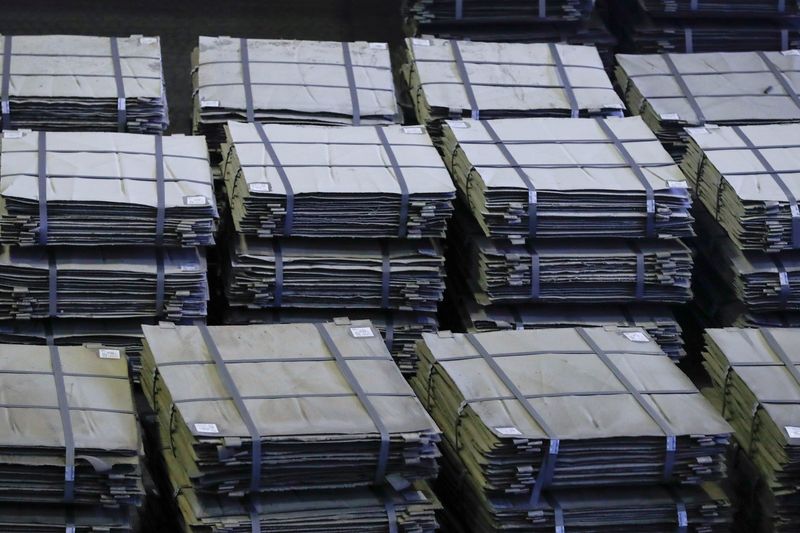By Pratima Desai
LONDON (Reuters) -With memories still fresh of the nickel market meltdown in March, the industry didn't need a reminder about just how dysfunctional the London Metal Exchange's (LME) nickel contract has become; but last month it got one anyway.
Months after turbulence highlighted shortcomings in LME oversight, the nickel contract remains broken. Volumes and liquidity are sliding, leaving the nickel industry without a global reference price - with far reaching consequences.
A major component of stainless steel, nickel is now also a key material for the electric vehicle industry, where it is used in the cathode component of batteries.
Declining liquidity, together with low stocks, has led to high LME nickel prices this year, pushing up costs for industrial users already grappling with surging inflation.
Global trade in metals is typically priced on the basis of LME contracts, but the lack of a reliable benchmark has led some nickel producers to take advantage by trying to go back to a system, used before there was a nickel contract, when they imposed prices on consumers, industry sources say.
The Shanghai Futures Exchange offers nickel futures, but because the Chinese government only allows domestic companies to trade it, the contract cannot be used as a global benchmark.
LIQUIDITY SLUMPS
Many investors, traders, consumers and producers have abandoned LME nickel in the aftermath of the chaos in March.
Worries about supplies from major producer Russia after it invaded Ukraine and the cutting of large short positions, or bets on lower nickel prices, culminated on March 8 in disorderly trade which saw prices double to above $100,000 a tonne in a matter of hours.
The exchange annulled all nickel trades on that day, for which it is facing legal action, and suspended the market for the first time since 1988.
Average daily nickel volumes have since crashed, down 54% to 196,868 tonnes in October from a year earlier, following year-on-year losses of 40%, 51% and 42% in September, August and July respectively.
As liquidity has slumped, excessive price moves have become more frequent.
LME nickel typically trades at a discount to the Shanghai Futures Exchange (ShFE) contract because China is a net importer of nickel and the ShFE nickel price takes into account logistical costs and local taxes.
But on Nov. 14 and 15 the LME's nickel contract traded at a premium to ShFE for the first time since March, which sources said was a sign of a dysfunctional market as it didn't reflect fundamentals.
Optimism fuelled by expectations of stronger industrial metals demand in top consumer China due to easing COVID curbs helped drive the price rise on Nov. 14, with the move inflated by some participants cutting short positions.
Unusually, there were periods on Nov. 14 and 15 when one buyer was consistently bidding nearly $1,000 above the rest of the market for the metal.
This combined with contract maturity fuelled an explosive upward move in nickel trading that was only stopped by the daily price limits of 15% imposed by the exchange in March.
The LME said its quick action in November calmed the market.
"The LME has the power to investigate unusual trading activity and to take disciplinary action as appropriate," the exchange said in response to a request for comment.
"The LME's daily price limits... operated as designed and limited the impact of the move. The LME immediately identified and queried specific underlying order and trade activity. Shortly after the LME queried this behaviour the price normalised."
RECKLESS BEHAVIOUR
Adding to the volatility on Nov. 14 were some offers to sell nickel at prices above the 15% daily price limit.
"It's surprising they (LME) haven't found a way to stop reckless behaviour that creates an existential threat to its nickel contract, one of the most important contracts this decade," a source at a nickel consuming company said.
Benchmark Mineral Intelligence (BMI) estimates nickel demand from the battery sector will account for 30% of the total at 4.8 million tonnes by 2030, up from 14% of three million tonnes this year, with most of that growth coming from electric vehicle batteries.
Nickel that can be delivered against the LME's contract is just 20% of global supplies, but many contracts between producers and consumers still reference the LME benchmark.
"The nickel contract will survive because there is no alternative, but it could take some time for a full recovery," said Guy Wolf head of market analytics at commodity broker Marex.
Benchmark nickel at $30,000 a tonne is up 50% from last December.
Industry sources say the only way to restore LME nickel's reputation as a global benchmark is the return of volumes and liquidity, but when and how that happens remains to be seen.

"There's a major disconnect between LME nickel (futures) and the physical market," a nickel trader said.
"People were beginning to tiptoe back into the market, this has put them off again."